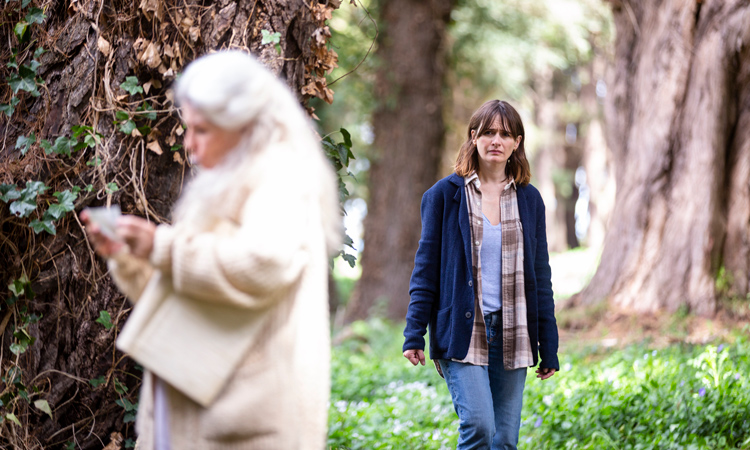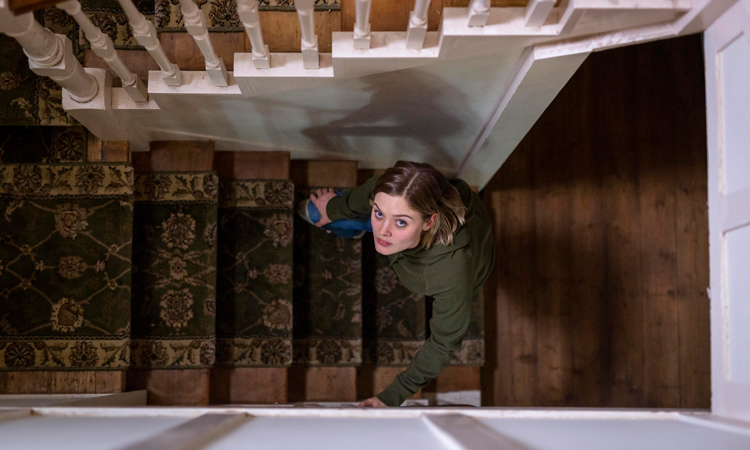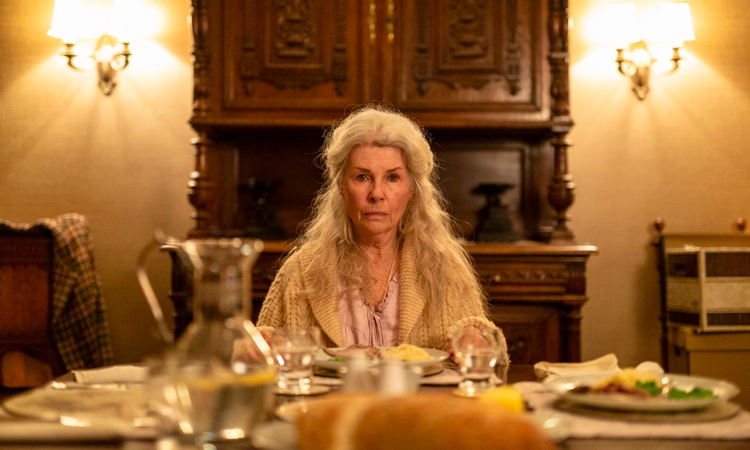“There’s something wonderful about horror that provides this kind of buffer between difficult subjects and the viewer,” says Australian writer and director Natalie Erika James as we discuss her debut feature, Relic. “It’s like being on a roller coaster at the same time as talking about grief.”
Relic follows three generations of women – grandmother Edna (Robyn Nevin), daughter Kay (Emily Mortimer) and granddaughter Sam (Bella Heathcote). The film begins when the latter two return to the family home after being told that Edna has gone missing. Upon entering the house, they find Post-Its strewn around – every day reminders that Edna has set herself to combat what looks like dementia. But the longer they spend in the house and the more they witness strange occurrings happening there, the more it seems there may be more at work here affecting the state of Edna’s mind.
A story about the real-life terror of dementia mixed with a supernatural tale of an old haunted house, Relic blurs the line between the reality and otherworldly… and we’re really not sure which one of the two is more terrifying.
“[The story] came from a really personal place,” James remembers. “My grandmother had Alzheimer’s, so I guess it was based on an original idea – coming from observations of her condition worsening and her relationship with my mother in particular, changing over time. I guess I’ve always been interested in the horror genre, but this story in particular felt like… maybe because when I started writing, I was visiting her and the house that she lived in used to really scare me as a kid and so all of my childhood nightmares resurfaced or something like that! Those two things kind of merged just to basically create the starting point.”
When Edna unexpectedly returns to the familial home – bloodied and covered in mud, and unsure of where she’s been – it’s clear to Sam and Kay that Edna is suffering from Alzheimer’s and the realisation of that both pulls the women together through their love of one another, and tears them apart through differing opinions on how to deal with the matter. Kay approaches the situation from a practical point-of-view and visits care homes for her mother, while Sam decides to step in and personally care for her grandmother. Meanwhile, Edna’s in strong denial and mainly want the two women to leave the house!
“Because it was my mother’s mother who had Alzheimer’s, it came to tell a story about the mother/daughter relationships,” James tells us. “There’s a really nice cohesion in this idea of three generations and seeing your future reflected in your mother, and by extension, your grandmother. I really like the unity of that, both thematically, but also visually as well.”

As Edna slowly gets over her ‘disappearance’ the two younger women decide to stay in the family house to keep an eye on her for a while. But as Edna’s behaviour becomes more and more erratic (and violent), they are forced to decide what the next steps are and soon Kay and Sam must face a very real scare: that the strong matriarch that they care for may soon be lost to her own mind forever.
“It definitely felt character-driven in the script,” says Bella Heathcote who plays Sam, remembering when she first read Relic’s story. “The script was really well written as well but it was the characters that really drew me into it. I felt like they all had a kind of even gravitas and were all really well written.”
Soon Edna, Kay and Sam’s (already unstable) relationships are tested as reality starts to hit home that the woman they once knew will soon be gone. It’s a heartbreaking story of real-life grief, and one that could only be handled with actors like Mortimer, Heathcote and Nevin.
“I’ve been a long big time fan of Emily Mortimer in particular and Bella Heathcote and Roybn [Nevin] – she’s really considered like a national treasure here [in Australia],” adds James. “I had the opportunity to meet them all in person before they signed on. I was so blown away by how much they connected with the script. I think the best you can do prior to meeting someone is look at their previous work and make the imaginative leap, but when you meet them you really get a sense of who they are, what they respond to and yeah, they just felt perfect.”
“I thought it was really awesome that it was just these three strong women carrying the story,” adds Heathcote. “But I didn’t realise how much of a bonus it would be until I was actually on set with them all!”
Of course, as with all real relationships, the one between Edna, Kay and Sam is very complex. Edna and Kay are very cool with each other (with hints that the former was very strict) while Sam doesn’t even call her mother ‘mum’. “That’s something else that I loved about it because I couldn’t call [Kay] ‘mom’,” Heathcote says. “It was so clear from the get-go that there was some tension between them. The way we talked about it was that Kay was pretty absent in Sam’s childhood; she’s a successful career woman and Sam spent a lot of time with her grandma and I think kind of resents Kay for that failure unfairly and calls her ‘Kay’ as a byproduct. I thought the dynamic between them was really interesting because it’s quite complex that both mother and daughter pairs had their own issues, which I thought was really cool to see represented in film.”
These complex and at times, tension-filled relationships, not only brings the film’s realism to the fore (making those horror elements all the more frightening) but it immediately draws in audiences to be a part of this awkward tension, ensuring you’re feeling very uncomfortable, even before the scares come.
“I really talked a lot about trying to portray relationships that were abrasive and not necessarily for one reason that you could point to, much like you do have in real life as well,” James explains. “There is a lot of love, but sometimes people’s personalities don’t gel, or there’s too much resentment or expectation or long term unspoken things that build up. So it wasn’t just this completely harmonious family. I think it adds complication to the whole process of aging because there’s so much upheaval in that.
“When the dynamics of your family are shifting and the parent has to become the child, sometimes the child has to parent the parent. That’s a really tumultuous time that can be fraught and full of ego and a lot of patience is required from both sides and a lot of re-establishing of where your boundaries are. So in a lot of ways, I feel like the fact that they don’t necessarily get on anyway just exacerbates things and it makes for a more fertile ground to explore the relationship.”
“Also, each of these women, because the dynamics are a bit complex, they aren’t always portrayed as perfectly likable necessarily,” Heathcote adds. “There was something in the script that trusted that the audience was clever enough that they would go along with these women and realise that even though they have disagreements and arguments, it doesn’t make them any less empathetic as characters or sympathetic as characters.”
“Yeah we kind of shied away from…. often when you write a script and you shop it around [there’s] this concentration on the ‘likeability’ of a character, particularly with women,” James agrees. “[But] we tried to embrace, you know, the messier sides of female relationships just as much as the love that can be in them.”

Though Edna is still very much alive, Kay and Sam begin to grieve for the strong woman she used to be, something that really resonated with Heathcote: “The depiction of Alzheimer’s and of grief – that idea of grieving someone when they’re still there – I just found so completely heartbreaking and powerful.”
“I also think if it’s your loved one [who’s going through Alzheimer’s], sometimes it can be quite unsettling in a way, like if they’re talking to people who aren’t there,” adds James. “Or if they’re seemingly living in the past or in two timelines. All of those things felt like a good fit for horror.”
Indeed, though the relationships are a central feature in Relic, this is a horror film; a genre that James felt was an important platform to tell this very personal story: “I feel like horror in particular is so personal because it is really writing from what personally scares you, and that’s really the only compass you have. When you decide to include something, it’s either thematic or it’s just a personal fear of yours. So basically I just watched my worst nightmare… twice!”
Horror has always been a good podium for diving into real-world issues and that is never more apparent than with Relic. Seeing someone you’ve known for your whole life suddenly become a complete (and at times, horrible) stranger sounds like it could come straight from a horror novel. Relic takes a small leap and turns it into a reality as Kay and Sam start to wonder if Edna has been suffering from something more than mental health issues while all alone in this house. Has their family home got something to do with Edna’s mental state?
“I do really like how horror allows you to talk about fear in a really interesting way,” James tells us. “Fear is such a primal emotion, and I think that the ability to externalise my fear and play with that visually and often in a surreal way is just really appealing in a genre framework. I also quite like how genre has all these conventions that you can subvert or embrace as it suits your themes or your needs. That’s really fun, and you can provide this really thrilling narrative engine to talk about something really important.”
“In my experience, horror scripts are probably the things that cross my path more than any other genre,” says Heathcote. “[But] it’s rare that you see one with such well-developed characters or with such an interesting storyline. I was just really blown away by [the idea of making a] horror film about Alzheimer’s – that decline, that emotional or psychological decline, and then having this physical manifestation. It’s so extraordinarily creative.”
The house that Edna lives in has been in the family for generations but it’s not long had a strange stained glass window installed from an old cabin that used to be on the property. When Kay suddenly suffers from nightmares of that old cabin, she can’t help but wonder if this is the connection between her house and her mother.
“I really attached to the idea of childhood nightmares, maybe because I had a lot as a kid,” James reveals. “I used to get a lot of sleep paralysis as well and would hallucinate like mad. So maybe part of it comes from there. I think particularly for this film there’s a real… having childhood nightmares relates to this idea that your parents are the ones who comfort you in those times when you wake up in the middle of the night and you’re scared. And to lose that is really to lose your safety net and in some ways that is the scariest thing. Alongside mortality of course.”

It’s at this point that the movie really blurs the line between reality and horror – it’s a family drama, in the family home, with horror coming at them from their own family… and the home itself!
“I’ve no doubt that you could write a similar film without the supernatural elements and still make it effective, but for me, I think the intensity of the genre elements almost lend you some insight into the experience in a way that a straight drama might not,” says James. “It’s just personal taste and how I wanted to explore that story, but for me they’re very interconnected. The film would be nothing without the drama but I think it wouldn’t hold up without the horror [either].”
A film that succinctly intertwines reality and horror is never going to give you a clean-cut three-act story with everything spelled out for you at the end. Relic is based in realism, and as with real life, things are just much more complicated than that.
“I have to say I’m a big fan of ambiguity and I think there is a loss in over-explaining mythology,” James tells us. “Obviously you have to have the audience follow it, but I’m more concerned with people following it emotionally and with something as nebulous as the supernatural, you kind of want it to make lyrical sense and poetic sense. But to really break it down to a supernatural mold; I feel like that can undermine some of the poetry of it.
“Yeah, 100% people want more answers, but it’s not really the type of film that is going to give you a big reveal about the cause of it. It’s speaking to real life and I guess that’s part of it. Massive questions like ‘why do we die? Why do we age?’ – for a screenwriter to give a definitive answer on that, or a filmmaker to say, ‘here’s why’, is a bit cold. I’m just playing with the ideas, not really dictating to you what they mean.”
Indeed, audiences may connect with Relic in varying ways, whether that’s from a personal experience, a personal fear or simply to enjoy a good old fashioned haunted house story. Either way, it’s doing what horror does best: drawing audiences in to a story that will stay with them long after they leave it.
“To a certain degree I really wanted it to be quite a cathartic experience for audiences,” says James. “For me, it’s more about the importance of connection in the face of those scary things, whether it’s mortality or Alzheimer’s itself and losing your mind or your memories. The best way you can love someone is just to be there with them through that and not shy away from that.
“In a way, I’ve always been interested thematically in the dualities between horror and beauty, so in some ways, there’s so much heartbreak with people aging and death, but at the same time it also makes our lives all the more poignant.”
Relic is released in cinemas and on digital HD on 30 October, with previews in showcase cinemas on 29 October.
